Interface Microstructure and Properties of 42CrMo/Cr5 Vacuum Billet Forged Composite Roll
Highlights
- Prolonged high-temperature exposure coarsens the grains of cast composite roll;
- A vacuum billet forging process for composite roll is proposed with simulation;
- With a 40% upset and 10% elongation, the interface achieves metallurgical bonding;
- The process promoted recrystallization and a uniform grain structure;
- The composite roll interface exhibits excellent interfacial properties.
Abstract
1. Introduction
2. Materials and Methods
2.1. Materials
2.2. Simulation and Experimental Process
2.2.1. Establishment of Finite Element Model
2.2.2. Experimental Procedure
2.3. Evaluation of Interface Structure and Mechanical Properties
3. Results and Analysis
3.1. Simulation of Forging Process for Composite Roll
3.2. Interface Microstructure Analysis of the Composite Roll
3.3. Elemental Analysis of the Interface in the Composite Roll
3.4. EBSD Analysis of the Interface in the Composite Roll
3.5. Analysis of Mechanical Performance at the Composite Roll Interface
3.6. Comparison Between Vacuum Billet Forging and Traditional Casting-Based Composite Roll Manufacturing Processes and Future Development Directions
3.6.1. Comparison Between Vacuum Billet Forging and Traditional Casting-Based Composite Roll Manufacturing Processes
3.6.2. Future Development Directions
4. Conclusions
Author Contributions
Funding
Institutional Review Board Statement
Informed Consent Statement
Data Availability Statement
Conflicts of Interest
References
- Li, H.C.; Jiang, Z.Y.; Tieu, A.K.; Sun, W.H.; Wei, D.B. Experimental study on wear and friction of work roll material with 4% Cr and added Ti in cold rolling. Wear 2011, 271, 2500–2511. [Google Scholar] [CrossRef]
- Mercado-Solis, R.D.; Talamantes-Silva, J.; Beynon, J.H.; Hernandez-Rodriguez, M.A.L. Modelling surface thermal damage to hot mill rolls. Wear 2007, 263, 1560–1567. [Google Scholar] [CrossRef]
- Hashimoti, M.; Tanaka, T.; Inoue, T.; Yamashita, M.; Kurahashi, R.; Terakado, R. Development of cold rolling mill rolls of high-speed steel type by using continuous pouring process for cladding. ISIJ Int. 2002, 42, 982–989. [Google Scholar] [CrossRef]
- Cao, Y.L.; Jiang, Z.H.; Dong, Y.W.; Deng, X.; Medovar, L.; Stovpchenko, G. Research on the bimetallic composite roll produced by an improved electroslag cladding method: Mathematical simulation of the power supply circuits. ISIJ Int. 2018, 58, 1052–1060. [Google Scholar] [CrossRef]
- Cen, Q.; Fu, H. A study of heat treatment of high-boron high-speed steel roll. Mater. Werkst. 2013, 44, 612–617. [Google Scholar] [CrossRef]
- Hou, Z.; Dong, Y.; Jiang, Z.; Medovar, L.; Stovpchenko, G.; Zou, T.; Dong, J. Interface bonding mechanism and heat treatment of the composite roll manufactured by electroslag remelting cladding method. J. Mater. Res. Technol. 2022, 19, 4115–4127. [Google Scholar] [CrossRef]
- Deng, G.Y.; Zhu, H.T.; Tieu, A.K.; Su, L.H.; Reid, M.; Zhang, L.; Wu, Q. Theoretical and experimental investigation of thermal and oxidation behaviours of a high speed steel work roll during hot rolling. Int. J. Mech. Sci. 2017, 131, 811–826. [Google Scholar] [CrossRef]
- Xu, L.; Wei, S.; Xiao, F.; Zhou, H.; Zhang, G.; Li, J. Effects of carbides on abrasive wear properties and failure behaviours of high speed steels with different alloy element content. Wear 2017, 376, 968–974. [Google Scholar] [CrossRef]
- Cao, Y.; Ma, C.; Jiang, Z.; Yan, J.; Li, G. Element migration and diffusion at the bonding interface of the bimetallic composite billet produced by the ESRC method. Metall. Mater. Trans. B 2022, 53, 2398–2406. [Google Scholar] [CrossRef]
- Wang, D.; Rong, S. Study on cast-weld process and composite interface of bimetal composite roll sleeve. J. Mater. Res. Technol. 2021, 12, 848–861. [Google Scholar] [CrossRef]
- Pellizzari, M.; Cescato, D.; De Flora, M.G. Hot friction and wear behaviour of high-speed steel and high-chromium iron for rolls. Wear 2009, 267, 467–475. [Google Scholar] [CrossRef]
- Shi, X.; Zhu, C.; Zhu, Z.; Chang, L. Present Situation and Key Technology Analysis of Bimetallic Composite Roll Preparation Method. J. Phys. Conf. Ser. 2020, 1637, 012096. [Google Scholar] [CrossRef]
- Rao, L.; Wang, S.J.; Zhao, J.H.; Geng, M.P.; Ding, G. Experimental and simulation studies on fabricating GCr15/40Cr bimetallic compound rollers using electroslag surfacing with liquid metal method. J. Iron Steel Res. Int. 2014, 21, 869–877. [Google Scholar] [CrossRef]
- Bai, Y.; Luan, Y.; Song, N.; Kang, X.; Li, D.; Li, Y. Chemical compositions, microstructure and mechanical properties of roll core used ductile iron in centrifugal casting composite roll. J. Mater. Sci. Technol. 2012, 28, 853–858. [Google Scholar] [CrossRef]
- Fu, H.G.; Zhao, A.M.; Xing, J.D.; Fu, D.M. Centrifugal casting of high-speed steel/nodular cast iron compound roll collar. J. Iron Steel Res. Int. 2002, 9, 32–35. [Google Scholar]
- Okabayashi, A.; Morikawa, H.; Tsujimoto, Y. Development and characteristics of high-speed steel rolls by centrifugal casting. In Proceedings of the South East Asia Iron and Steel Institute, SEAISI 1997 Korea Conference on “Flat Product Technology”, Seoul, Republic of Korea, 12–14 May 1997. [Google Scholar]
- Ichino, K.; Kataoka, Y.; Yuda, K. Development of centrifugal cast roll with high wear resistance for finishing stands of hot strip mills. Kawasaki Steel Giho 1996, 28, 89–94. [Google Scholar]
- Kim, C.K.; Kim, Y.C.; Park, J.I.; Lee, S.; Kim, N.J.; Yang, J.S. Effects of alloying elements on microstructure, hardness, and fracture toughness of centrifugally cast high-speed steel rolls. Metall. Mater. Trans. A 2005, 36, 87–97. [Google Scholar] [CrossRef]
- Marukovich, E.I.; Branovitsky, A.M.; Na, Y.S.; Lee, J.H.; Choi, K.Y. Study on the possibility of continuous-casting of bimetallic components in condition of direct connection of metals in a liquid state. Mater. Des. 2006, 27, 1016–1026. [Google Scholar] [CrossRef]
- Hashimoto, M.; Otomo, S.; Yoshida, K.; Kimura, K.; Kurahashi, R.; Kawakami, T.; Kouga, T. Development of high-performance roll by continuous pouring process for cladding. ISIJ Int. 1992, 32, 1202–1210. [Google Scholar] [CrossRef]
- Tanaka, T.; Koie, T.; Ayagaki, M.; Yamashita, M.; Hashimoto, M.; Otomo, S.; Inoue, T. High-speed steel type cold rolling mill roll by continuous pouring process for cladding. Nippon Steel Tech. Rep. 2002, 86, 80–85. [Google Scholar]
- Cao, Y.; Li, G.; Jiang, Z.; Dong, Y.; Zhao, Z.; Niu, C. Microstructure evolution of roll core during the preparation of composite roll by electroslag remelting cladding technology. High Temp. Mater. Process. 2020, 39, 270–280. [Google Scholar] [CrossRef]
- Cao, Y.L.; Jiang, Z.H.; Dong, Y.W.; Deng, X.; Medovar, L.; Stovpchenko, G. Research on the bonding interface of high-speed steel/ductile cast iron composite roll manufactured by an improved electroslag cladding method. Metals 2018, 8, 390. [Google Scholar] [CrossRef]
- Yu, M.; Kuskov, S.; Soloviov, V.G.; Zhdanov, V.A. Electroslag surfacing of end faces with large-section electrode in current-supplying mould. Paton Weld. J. 2017, 12, 29–32. [Google Scholar]
- Ghosh, S.; Sinha, P.; Indimath, S.; Mukhopadhyay, G.; Bhattacharya, S. Ribbon fatigue spalling of a forged work roll used at a cold rolling mill. J. Fail. Anal. Prev. 2014, 14, 707–714. [Google Scholar] [CrossRef]
- Ji, H.; Duan, H.; Li, Y.; Li, W.; Huang, X.; Pei, W.; Lu, Y. Optimization the working parameters of as-forged 42CrMo steel by constitutive equation-dynamic recrystallization equation and processing maps. J. Mater. Res. Technol. 2020, 9, 7210–7224. [Google Scholar] [CrossRef]
- Song, X.Y.; Zhang, X.J.; Fu, L.C.; Yang, H.B.; Yang, K.; Zhu, L. Evaluation of microstructure and mechanical properties of 50Cr5NiMoV steel for forged backup roll. Mater. Sci. Eng. A 2016, 677, 465–473. [Google Scholar] [CrossRef]
- Li, Y.; Wu, Q.; Liu, C. Effects of chemical composition and heat treatment on wear properties of backup rolls steel. Mater. Express 2019, 9, 764–772. [Google Scholar] [CrossRef]
- GB/T 3077-2015; Alloy Structure Steels. In General Administration of Quality Supervision, Inspection and Quarantine of the People’s Republic of China, Standardization Administration of the People’s Republic of China. Standards Press of China: Beijing, China, 2015.
- GB/T 1299-2014; Tool and Mould Steels, Inspection Methods of Microstructure for Metals. General Administration of Quality Supervision, Inspection and Quarantine of the People’s Republic of China-Standardization Administration of China: Beijing, China., 2014.
- Qian, D.; Sun, M.; Wang, F.; Xie, L.; Hua, L. Dynamic recrystallization behaviors and cracking mechanism for the hot deformation of new-generation high nitrogen bearing steel. Mater. Des. 2024, 241, 112891. [Google Scholar] [CrossRef]
- Kang, Y.J.; Oh, J.C.; Lee, H.C.; Lee, S. Effects of carbon and chromium additions on the wear resistance and surface roughness of cast high-speed steel rolls. Metall. Mater. Trans. A 2001, 32, 2515–2525. [Google Scholar] [CrossRef]
- Beswick, J.M. The effect of chromium in high carbon bearing steels. Metall. Trans. A 1987, 18, 1897–1906. [Google Scholar] [CrossRef]
- Wenk, H.R.; Van Houtte, P. Texture and anisotropy. Rep. Prog. Phys. 2004, 67, 1367. [Google Scholar] [CrossRef]
- Doherty, R.D.; Hughes, D.; Humphreys, F.J.; Jonas, J.J.; Jensen, D.J.; Kassner, M.E.; King, W.E.; McNelley, T.R.; McQueen, H.J.; Rollett, A.D. Current issues in recrystallization: A review. Mater. Sci. Eng. A 2003, 238, 219–274. [Google Scholar] [CrossRef]
- Gourdet, S.; Montheillet, F.J.A.M. A model of continuous dynamic recrystallization. Acta Mater. 2003, 51, 2685–2699. [Google Scholar] [CrossRef]
- Zeng, X.Y.; Wang, Y.X.; Li, X.Q.; Li, X.J.; Zhao, T.J. Effect of inert gas-shielding on the interface and mechanical properties of Mg/Al explosive welding composite plate. J. Manuf. Process. 2019, 45, 166–175. [Google Scholar] [CrossRef]
- Li, Y.; Gao, J.; Xu, N.; Li, P.; Gong, M.; Tong, W. Fabrication of a high chromium cast iron/low carbon steel bimetal: Diffusion behavior and bonding strength. J. Mater. Eng. Perform. 2019, 28, 6904–6911. [Google Scholar] [CrossRef]
- Ye, Q.; Li, X.; Tayyebi, M.; Assari, A.H.; Polkowska, A.; Lech, S.; Polkowski, W.; Tayebi, M. Effect of heat treatment parameters on microstructure evolution, tensile strength, wear resistance, and fracture behavior of Ni-Ti multilayered composites produced by cross-accumulative roll bonding. Arch. Civ. Mech. Eng. 2022, 23, 27. [Google Scholar] [CrossRef]
- Cao, Y.; Jiang, Z.; Dong, Y.; Li, G.; Hou, Z.; Wang, Q. Research on the bimetallic composite roll produced by a new electroslag cladding method: Microstructure and property of the bonding interface. Ironmak. Steelmak. 2020, 47, 686–692. [Google Scholar] [CrossRef]
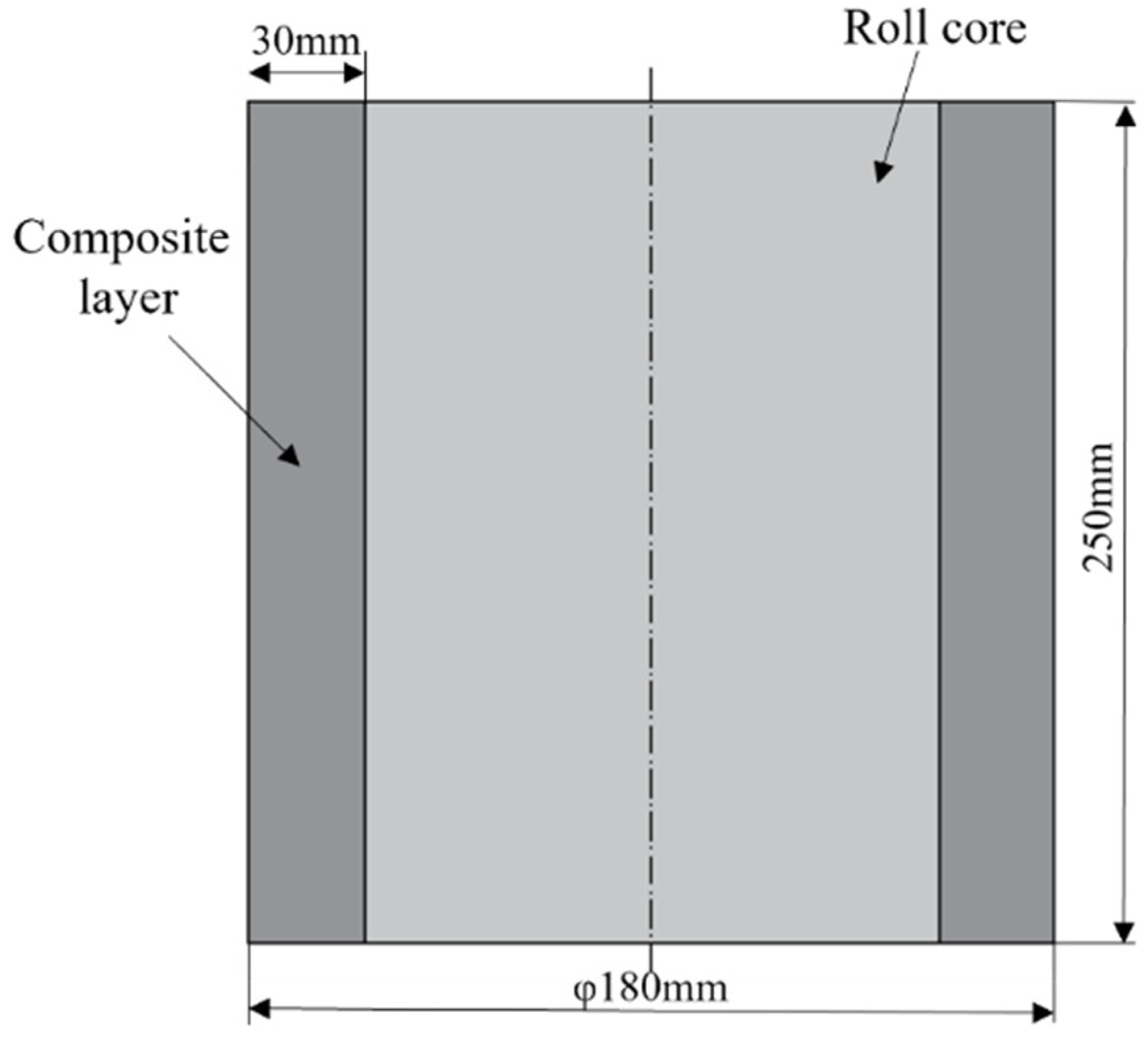
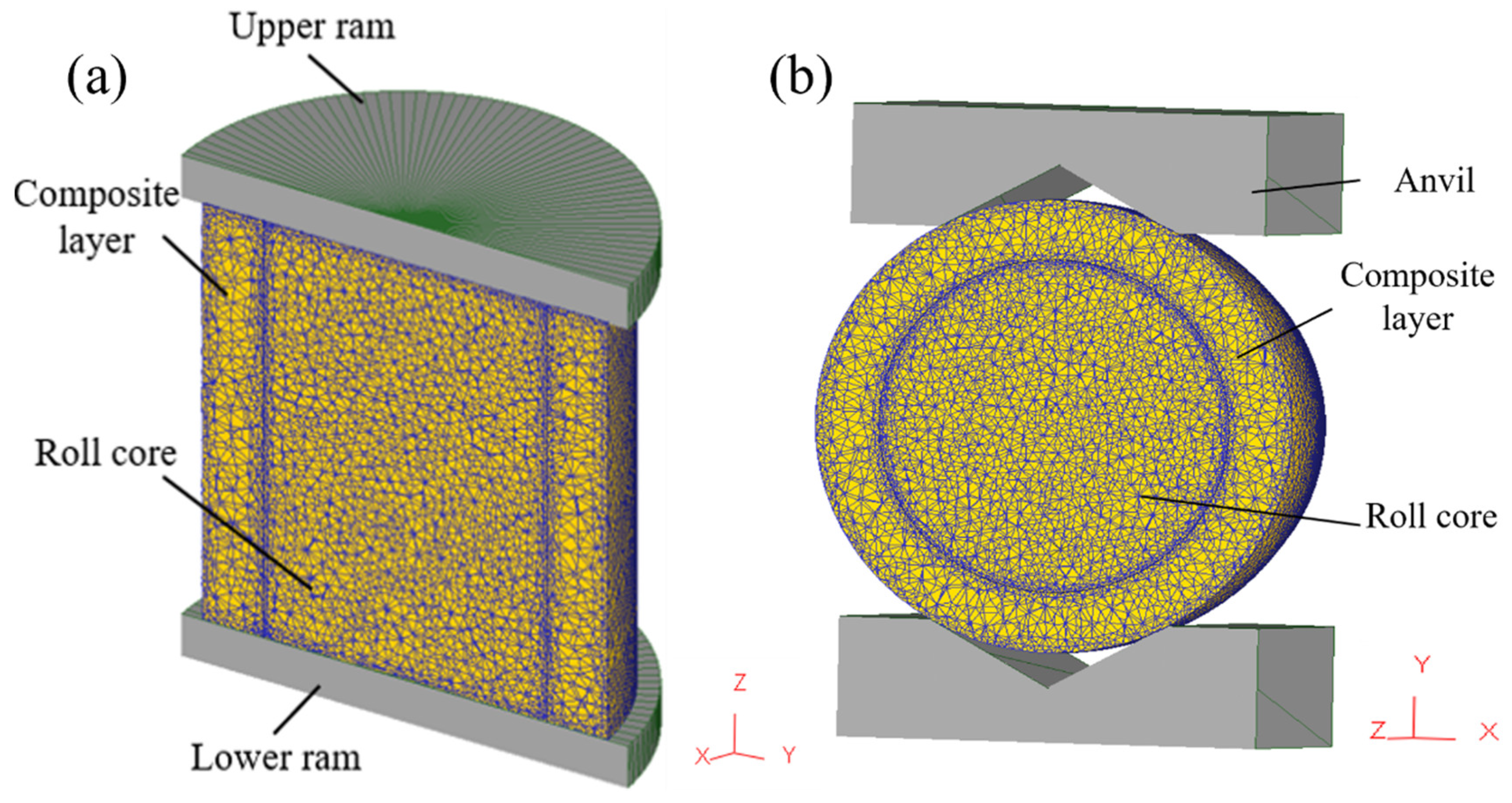

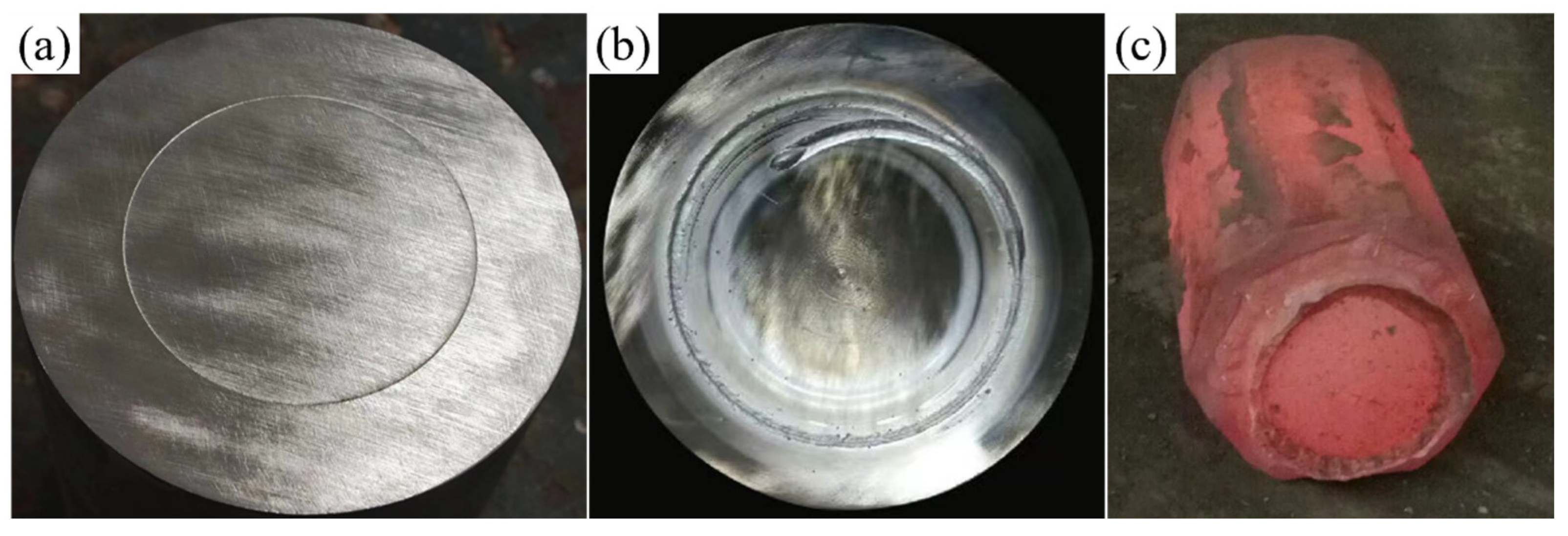
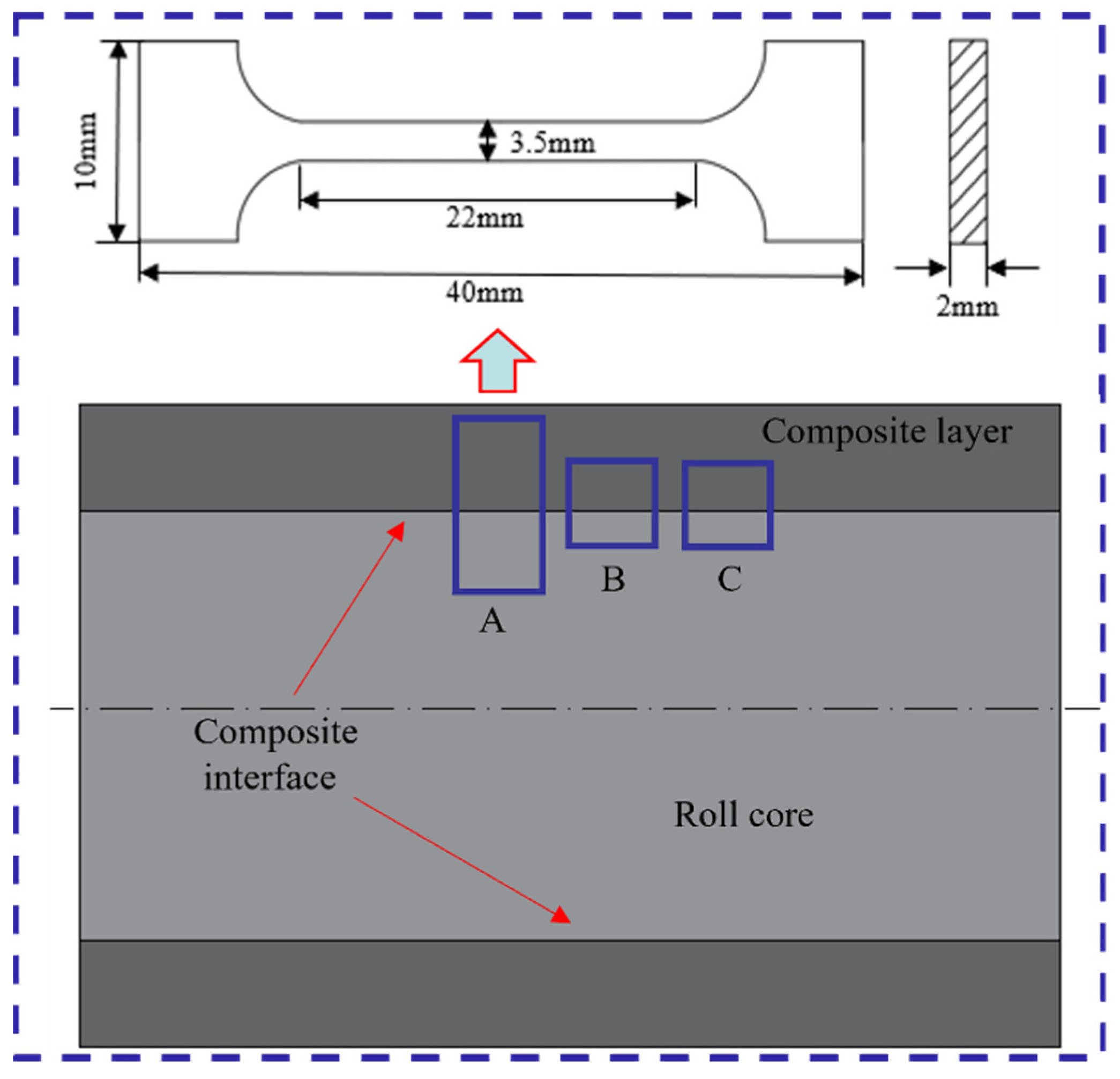
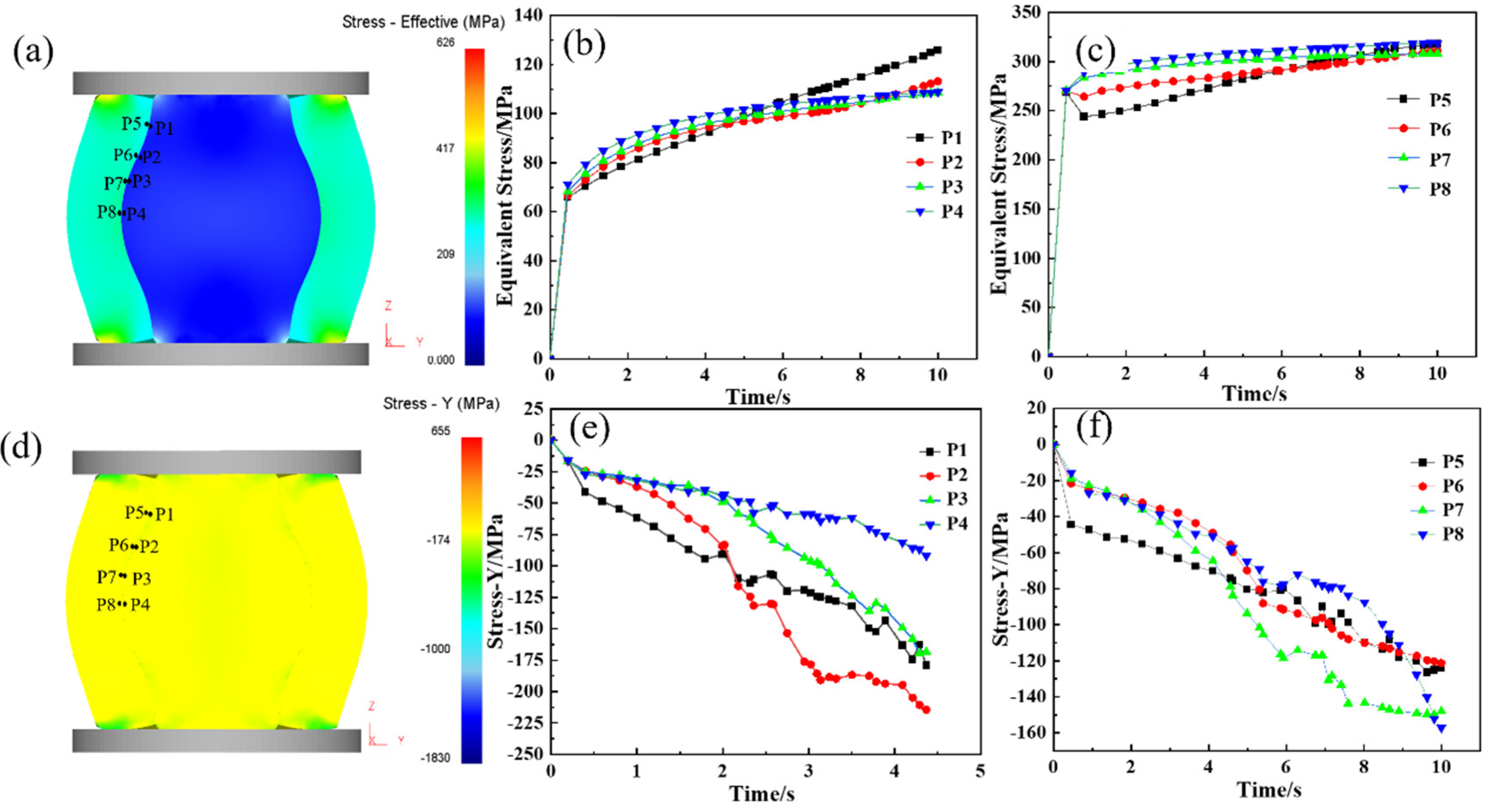
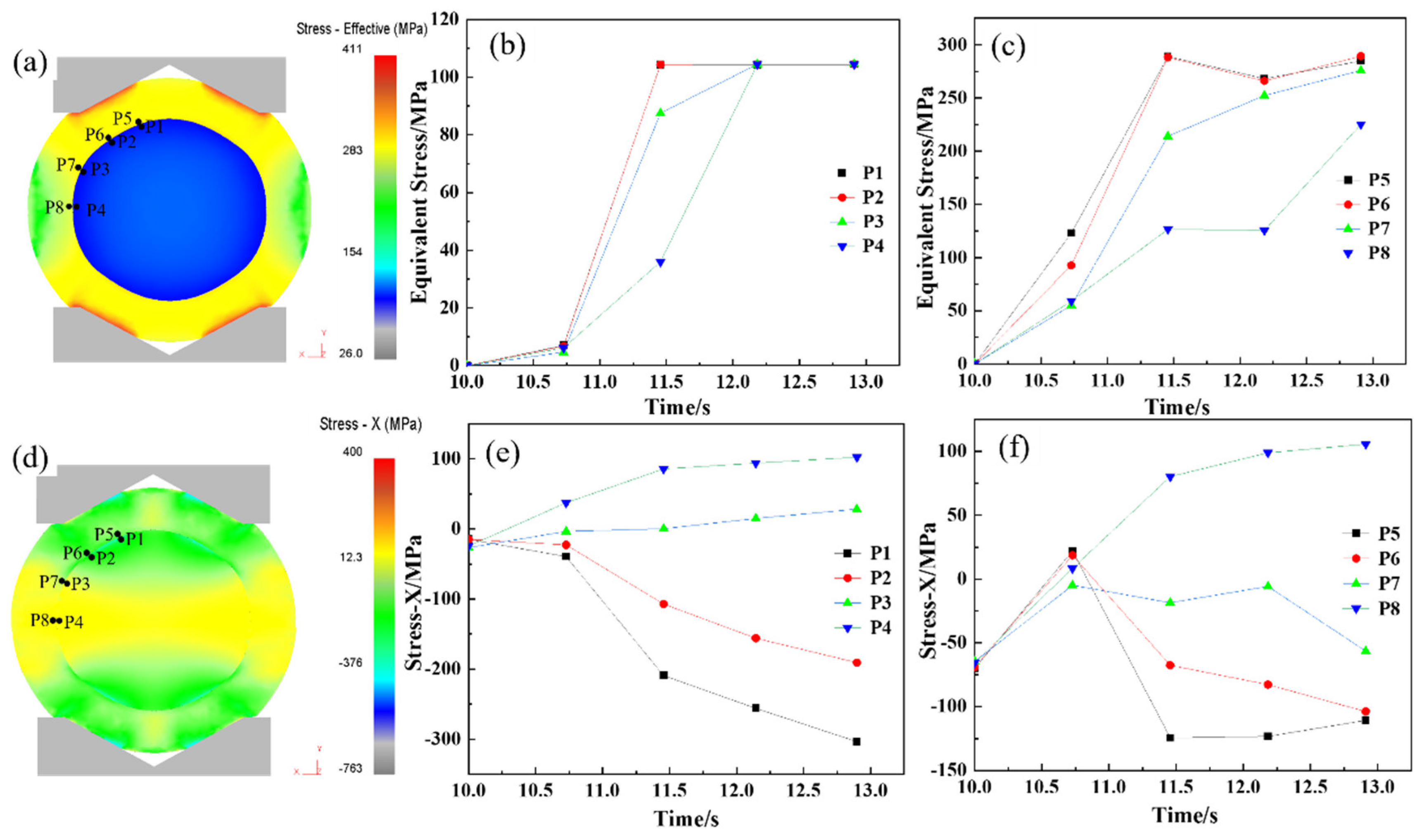

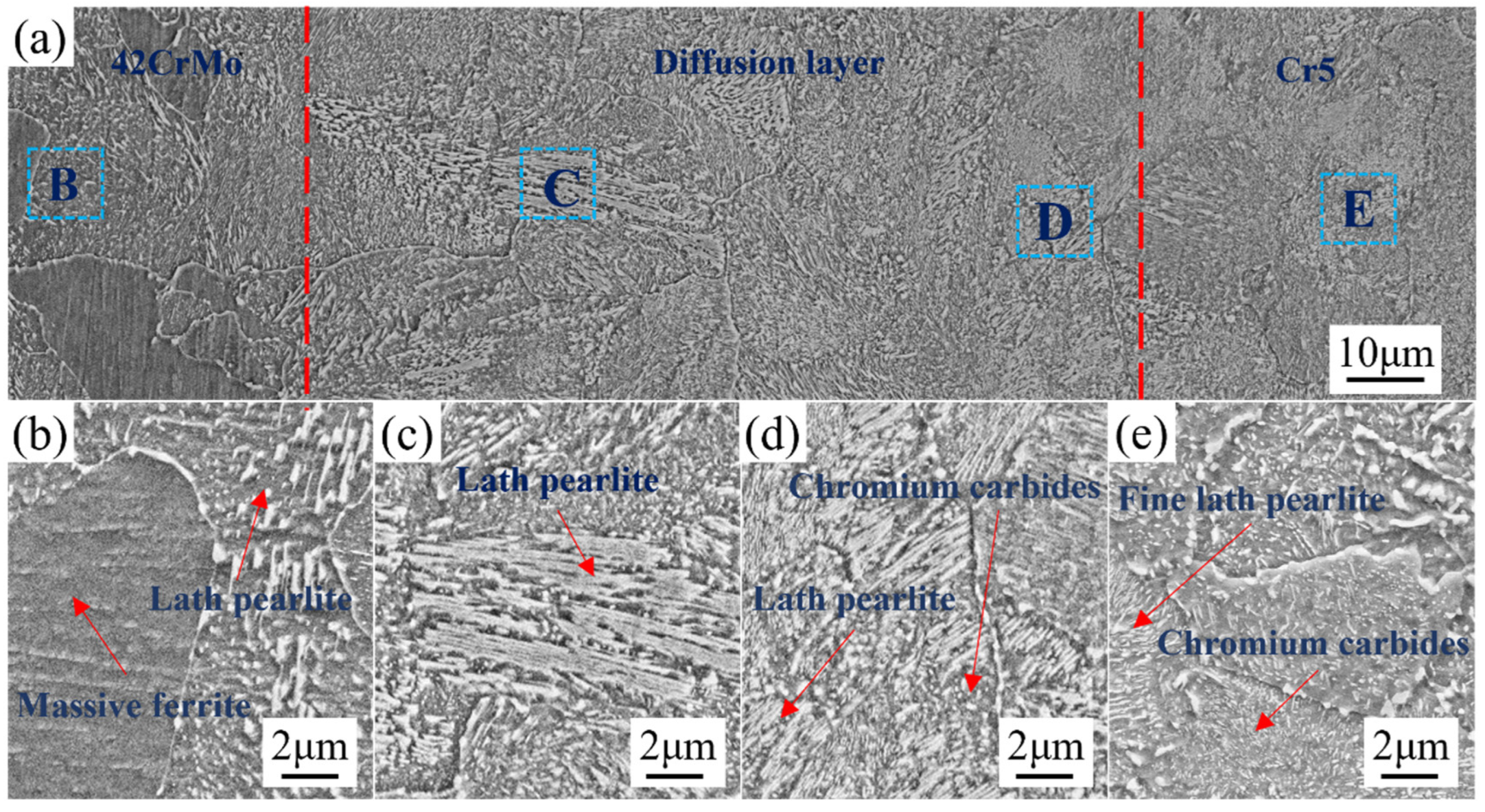
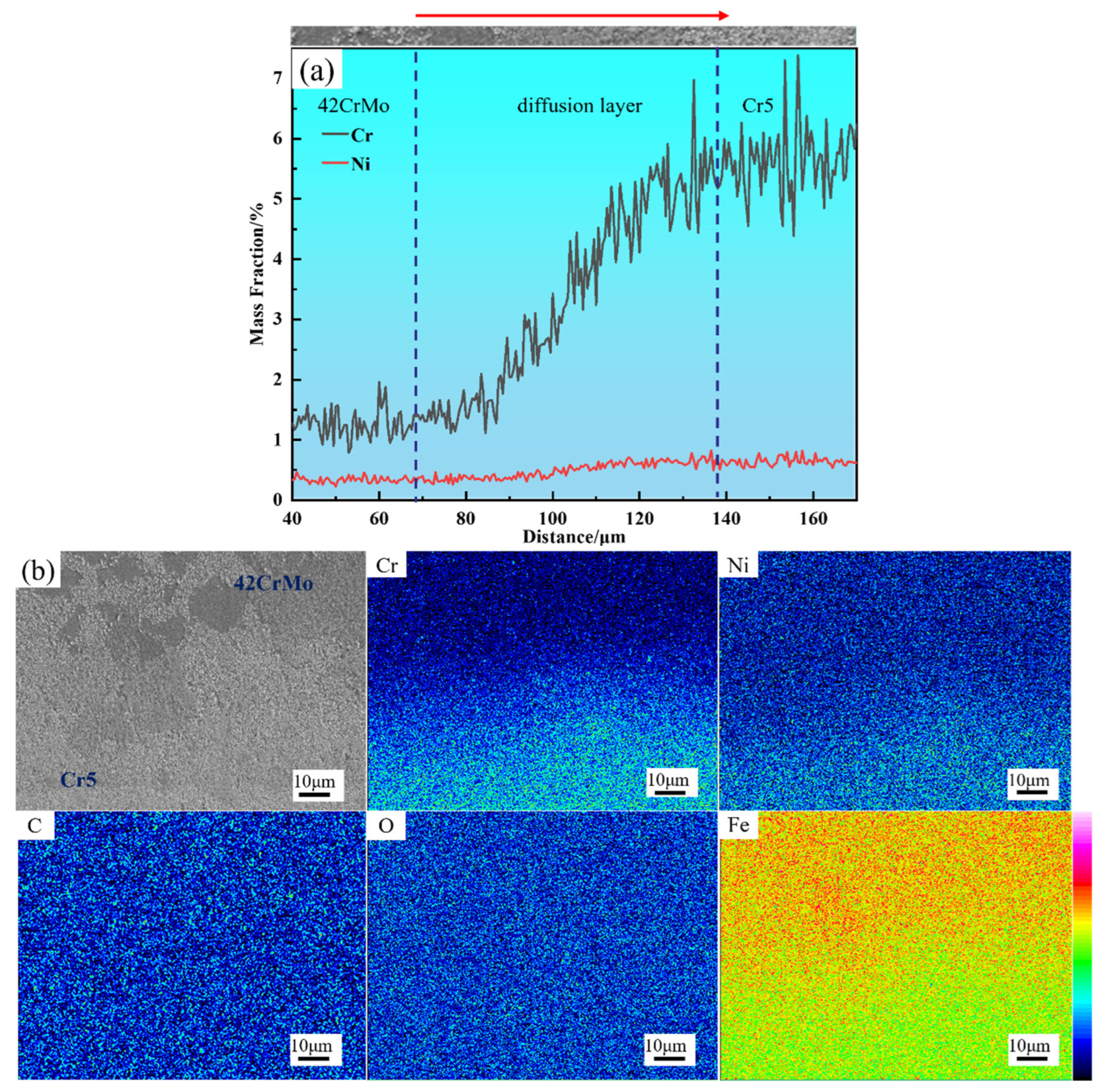
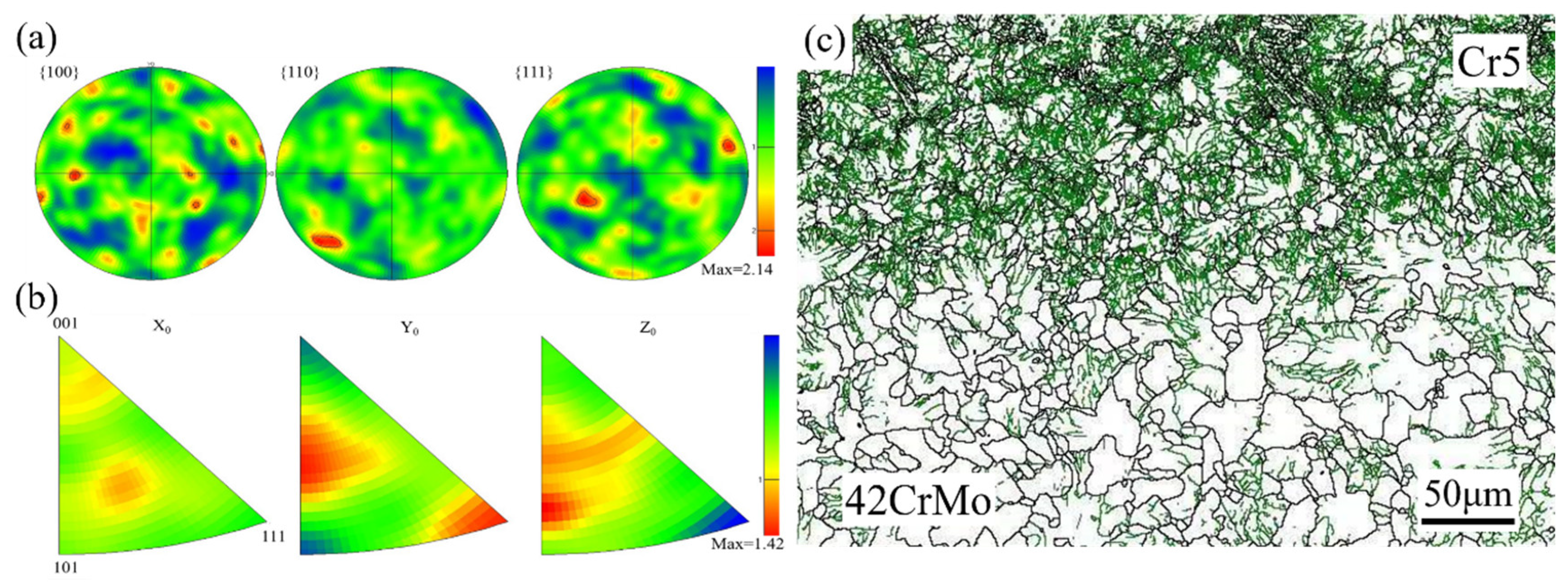

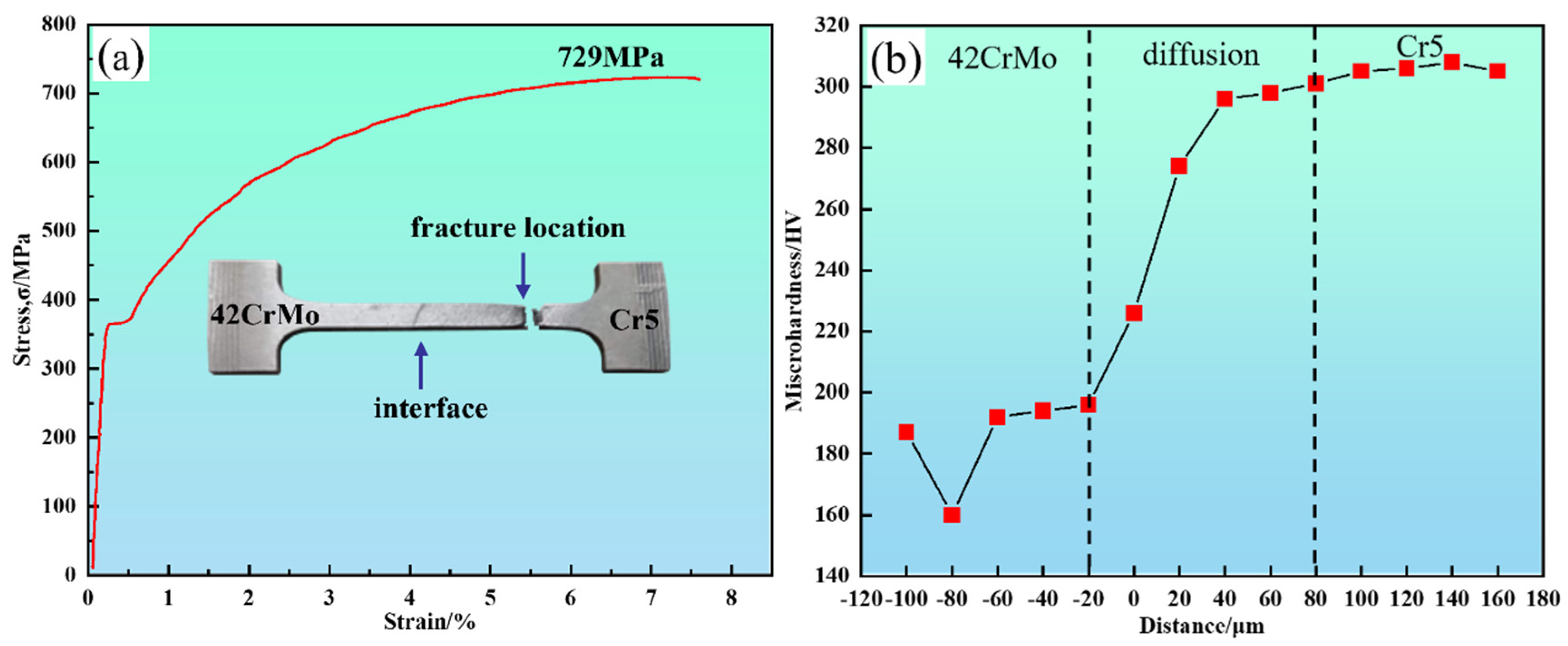
| Element | C | Si | Mn | Cr | Ni | Mo | V | Fe |
|---|---|---|---|---|---|---|---|---|
| Roll core | 0.42 | 0.25 | 0.78 | 1.08 | 0.36 | 0.23 | 0.00 | Bal. |
| Composite layer | 0.45 | 0.35 | 0.43 | 4.85 | 0.72 | 0.25 | 0.12 | Bal. |
| Temperature (°C) | Elasticity Modulus (GPa) | Specific Heat Capacity [kJ/(kg·°C)] | Thermal Conductivity [N/(s·°C)] | Coefficient of Linear Expansion (1/°C) |
|---|---|---|---|---|
| 950 | 114.16 | 0.62 | 28.02 | 2.27 |
| 1000 | 109.34 | 0.63 | 28.66 | 2.40 |
| 1050 | 103.76 | 0.64 | 29.25 | 2.52 |
| 1100 | 98.86 | 0.65 | 29.86 | 2.65 |
| 1150 | 93.92 | 0.66 | 30.45 | 2.77 |
| 1200 | 88.96 | 0.67 | 31.04 | 2.89 |
| Temperature (°C) | Elasticity Modulus (GPa) | Specific Heat Capacity [kJ/(kg·°C)] | Thermal Conductivity [N/(s·°C)] | Coefficient of Linear Expansion (1/°C) |
| 950 | 116.08 | 0.76 | 27.80 | 2.25 |
| 1000 | 110.95 | 0.62 | 28.64 | 2.38 |
| 1050 | 106.93 | 0.63 | 29.22 | 2.51 |
| 1100 | 101.62 | 0.64 | 29.81 | 2.64 |
| 1150 | 96.91 | 0.65 | 30.39 | 2.76 |
| 1200 | 92.17 | 0.66 | 30.97 | 2.88 |
| Yield Strength (MPa) | Tensile Strength (MPa) | Elongation (%) | Hardness Range (HV) |
|---|---|---|---|
| 360~370 | 725~729 | 7.0~7.7% | 190~305 |
| Vacuum Billet Forging | Centrifugal Casting | Continuous Casting | Electroslag Remelting | |
|---|---|---|---|---|
| Performance | Superior interface quality with refined microstructure | Moderate interface quality, prone to segregation and weaker bonding | Good bonding with reduced segregation | High bonding Quality, fine structure but energy-intensive |
| Cost | Higher initial cost due to specialized equipment | Low, cost-effective for mass production | Higher cost due to energy demand and longer processing | High cost, largely due to energy consumption |
| Scalability | Suitable for small- to large-scale production with high performances | Excellent for large-scale production | Moderate scalability, requires precise control | Limited Scalability, due to long processing time |
| Environmental Impact | Low emissions | Moderate emissions, molten metal handling contributes to oxidation | Moderate, requires significant energy | High energy consumption and environmental emissions |
Disclaimer/Publisher’s Note: The statements, opinions and data contained in all publications are solely those of the individual author(s) and contributor(s) and not of MDPI and/or the editor(s). MDPI and/or the editor(s) disclaim responsibility for any injury to people or property resulting from any ideas, methods, instructions or products referred to in the content. |
© 2024 by the authors. Licensee MDPI, Basel, Switzerland. This article is an open access article distributed under the terms and conditions of the Creative Commons Attribution (CC BY) license (https://creativecommons.org/licenses/by/4.0/).
Share and Cite
Li, M.; Luo, Z.; Zhou, H.; Yang, J.; Xie, G.; Wang, G.; Liu, J.; Han, W.; Xin, S. Interface Microstructure and Properties of 42CrMo/Cr5 Vacuum Billet Forged Composite Roll. Materials 2025, 18, 122. https://doi.org/10.3390/ma18010122
Li M, Luo Z, Zhou H, Yang J, Xie G, Wang G, Liu J, Han W, Xin S. Interface Microstructure and Properties of 42CrMo/Cr5 Vacuum Billet Forged Composite Roll. Materials. 2025; 18(1):122. https://doi.org/10.3390/ma18010122
Chicago/Turabian StyleLi, Ming, Zongan Luo, Hongyu Zhou, Jingsong Yang, Guangming Xie, Guodong Wang, Jikui Liu, Weiguo Han, and Shengpeng Xin. 2025. "Interface Microstructure and Properties of 42CrMo/Cr5 Vacuum Billet Forged Composite Roll" Materials 18, no. 1: 122. https://doi.org/10.3390/ma18010122
APA StyleLi, M., Luo, Z., Zhou, H., Yang, J., Xie, G., Wang, G., Liu, J., Han, W., & Xin, S. (2025). Interface Microstructure and Properties of 42CrMo/Cr5 Vacuum Billet Forged Composite Roll. Materials, 18(1), 122. https://doi.org/10.3390/ma18010122





